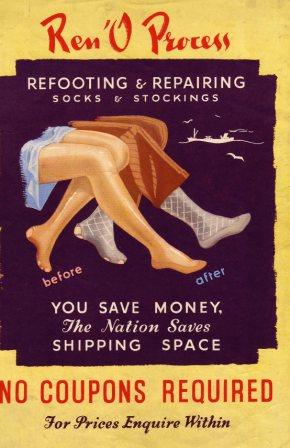 Whenever I give a talk about wartime fashion I get a host of memories from audience members who recall parachute silk dresses, Make-Do-And-Mend shirts, thrice darned stockings and coats made from blankets. Some people remember the era with pleasure and tell me about how they loved their Liberty bodice or their Land Army uniform. Others recall patched jumpers and empty department stores. But almost everyone has something to say about underwear. I suppose it is the most intimate detail and it is endlessly fascinating but if someone were to ask me what kind of undies I wore when I was growing up in the 1970s I would be pushed to know. There is something that is very ingrained in the collective memory about wartime knickers, bras and, above all, corsets.
Whenever I give a talk about wartime fashion I get a host of memories from audience members who recall parachute silk dresses, Make-Do-And-Mend shirts, thrice darned stockings and coats made from blankets. Some people remember the era with pleasure and tell me about how they loved their Liberty bodice or their Land Army uniform. Others recall patched jumpers and empty department stores. But almost everyone has something to say about underwear. I suppose it is the most intimate detail and it is endlessly fascinating but if someone were to ask me what kind of undies I wore when I was growing up in the 1970s I would be pushed to know. There is something that is very ingrained in the collective memory about wartime knickers, bras and, above all, corsets.

There is almost a whole chapter devoted to corsets in Fashion on the Ration because it was a topic that exercised not only women who wore them but the civil servants in the Board of Trade who had to guarantee their supply. And it was no easy job. Over 18 million women wore corsets in the late 1930s but wartime production dropped to just 9 million a year and this was the cause of much heartache, not to say irritation. The reason is simple: corsets were made up of three important constituent parts, all of which were necessary for the war industry. Metal was needed for aircraft production so the stays were replaced with compressed cardboard, with disastrous results. Cotton supplies dropped during the war as world cotton prices rose and the number employed in the cotton spinning and weaving industry fell by thirty percent. Rubber became a rare and precious commodity after the fall of Singapore in spring 1942 as the Japanese held the majority of the world’s rubber supplies in the Far East. Finally, the expert corset makers, with their highly skilled workforce of machine operators, often switched to making parachutes, to which their expertise and equipment was ideally suited. As a result, corsets
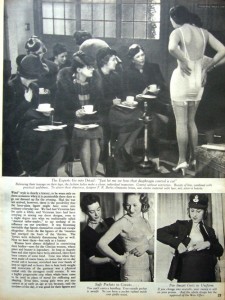
were in short supply and what was available was often very poor quality.One young mother, who had just given birth in the summer of 1944, wrote a furious letter which was published in Time magazine in which she took the Board of Trade to task, even naming Hugh Dalton, the then president, in her diatribe: ‘There should be no false modesty about this very essential article … After the birth of my second child the sight of my figure enclosed in a utility corset nearly paralysed me. True, it caused a certain amusement to my family, but I didn’t feel funny, only ill and unhappy … I found that the boning at the front consisted of three pieces of compressed cardboard. I defy even the most pugnacious cardboard to do anything but follow the shape of the figure it encloses … A band of infuriated housewives should force Mr Dalton into a utility corset and a pair of the best fitting utility stockings he can buy. I would add a saucy black felt hat for which he had to pay four guineas and a pair of those ghastly wooden-soled shoes. He should be made to walk one mile, then stand in a fish queue for an hour. By the end of this time his utility stockings would [droop] from knee to instep in snakelike coils and twists. His corset would have wilted into an uncomfortable, revolting mass of cotton and cardboard. He would find himself supporting the corset, instead of the corset supporting him. May I suggest this would be a very speedy remedy?’
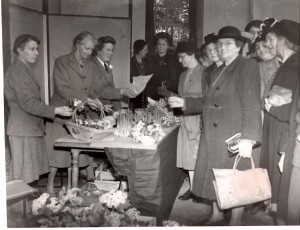
This glorious image may raise a smile but it was a serious matter and many women, who had been used to the support of their pre-war Berlei or Spirella corset felt uncomfortable and very aggrieved. And queuing was something that women had to do on a daily basis, often for hours on end while they waited for food to appear in the shops or on a market stall. The women’s fashion magazines did their best to advise women on ways of keeping their corsets in good order and they encouraged young women to learn to do without by practising core body exercises.
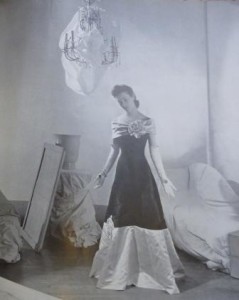
But Fashion on the Ration was not just a story of utility corsets, grey Forces bloomers and austerity designs for skirts and coats. There was another side to the story which I had not expected to find and this was the significant role played by the haute couture houses in designing fashion for the export market. Export sales brought in much-needed currency and over the period of 1938 to 1946 fashion exports rose from £98,000 to £507,000. Paris, as the centre of the fashion world, was out of the picture from 1940 until the liberation of France in 1944 and London was quick to take its place. Shows were organised for South America, South Africa and the USA with designs by Molyneux, Hardy Amies, Digby Morton, Norman Hartnell and Bianca Mosca rising ‘phoenix-like…from our dustsheeted London life.’
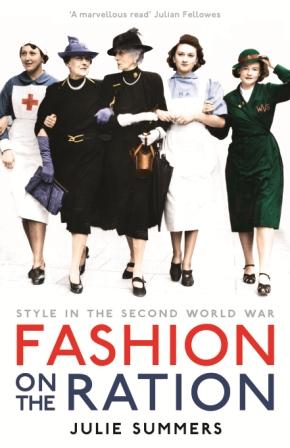
Fashion on the Ration came out in paperback on 25 March and the exhibition which it accompanied at the Imperial War Museum in London last year will be reopening, slightly enlarged, at IWM/North at the end of May 2016.